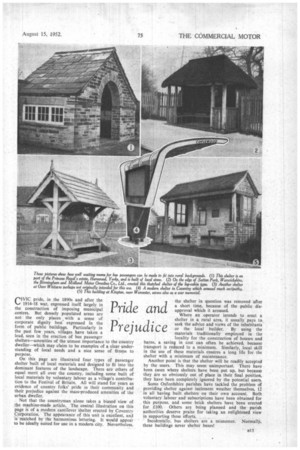Pride and Prejudice
Page 49

If you've noticed an error in this article please click here to report it so we can fix it.
r1VIC pride, in the 1890s and after the
1914-18 war, expressed itself largely in the construction of imposing municipal centres. But densely populated areas are not the only places with a sense of corporate dignity best expressed in the form of public buildings. Particularly in the past few years, villages have taken a lead, seen in the erection of bus passenger shelters—amenities of the utmost importance to the country dweller—which may claim to be examples of a clear understanding of local needs and a nice sense of fitness to purpose.
On this page are illustrated four types of passenger shelter built of local materials and designed to fit into the dominant features of the landscape. There are others of equal merit all over the country, including some built of local materials by voluntary labour as a village's contribution to the Festival of Britain. All will stand for years as evidence of country folks' pride in their community and their prejudice against the mass-produced amenities of the urban dweller.
Not that the countryman alone takes a biased view of the machine-made article. The central illustration on this page is of a modern cantilever shelter erected by Coventry Corporation. The appearance of this unit is excellent, and is matched by the harmonious lettering. It would appeir to be ideally suited for use in a modern city. Nevertheless,
the shelter in question was removed after a short time, because of the public disapproval which it aroused.
Where an operator intends to erect a shelter in a rural area, it usually pays to seek the advice and views of the inhabitants or the local builder. By using the materials traditionally employed in the locality for the construction of houses and barns, a saving in cost can often be achieved, because transport is reduced to a minimum. Similarly, local skill in the use of these materials ensures a long life for the shelter with a minimum of maintenance.
Another point is that the shelter will be readily accepted by the users. This may seem unimportant. There have been cases where shelters have been put up, but because they are so obviously out of place in their final position, they have been completely ignored by the potential users.
Some Oxfordshire parishes have tackled the problem of providing shelter against inclement weather themselves, 12 in all having built shelters on their own account. Both voluntary labour and subscriptions have been obtained for this purpose, and some brick shelters have been erected for £100. Others are being planned and the parish authorities deserve praise for taking an enlightened view in supporting these efforts. . , ' Incidentally, bus shelters are a misnomer. Normally, these buildings never shelter buses!




















































































